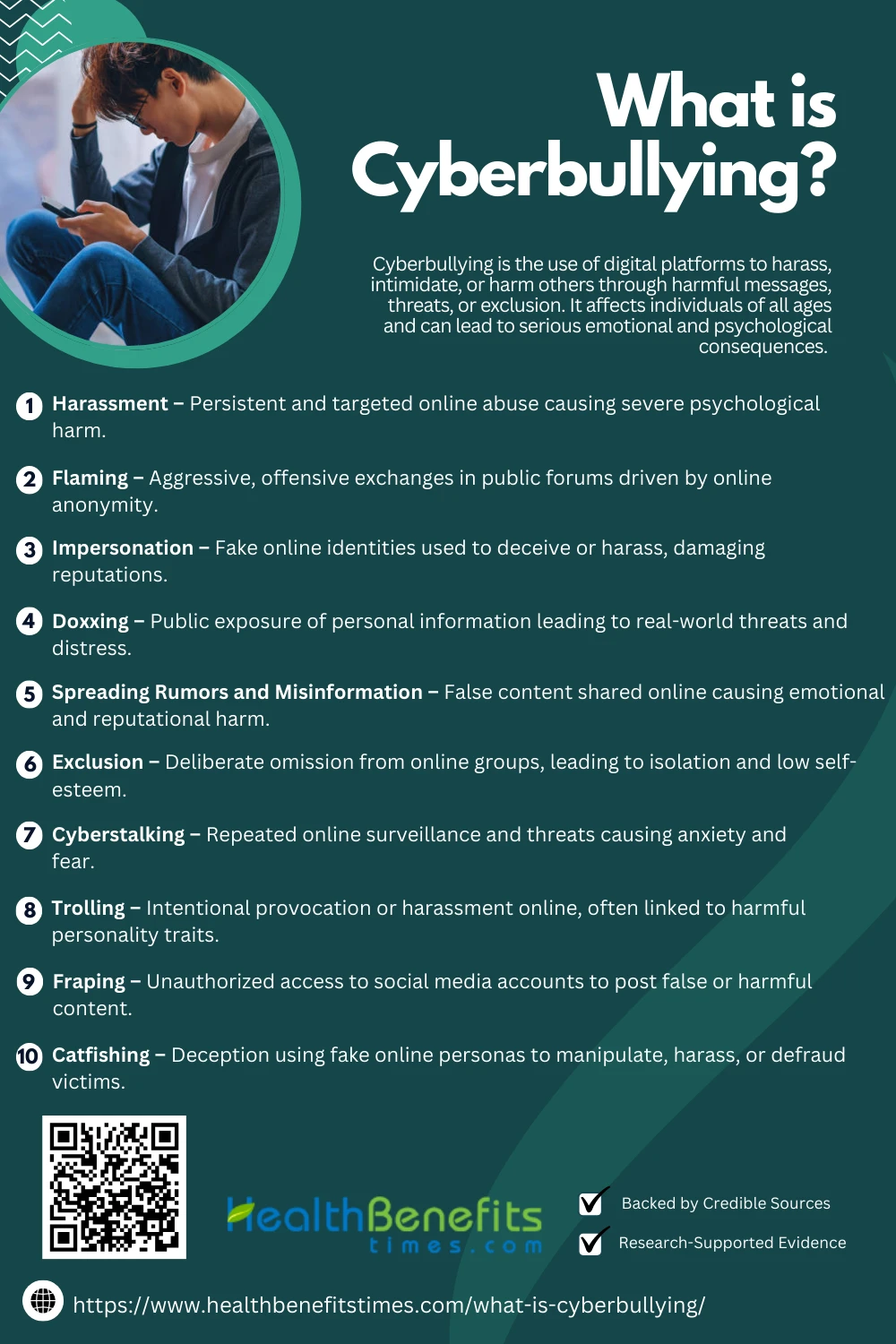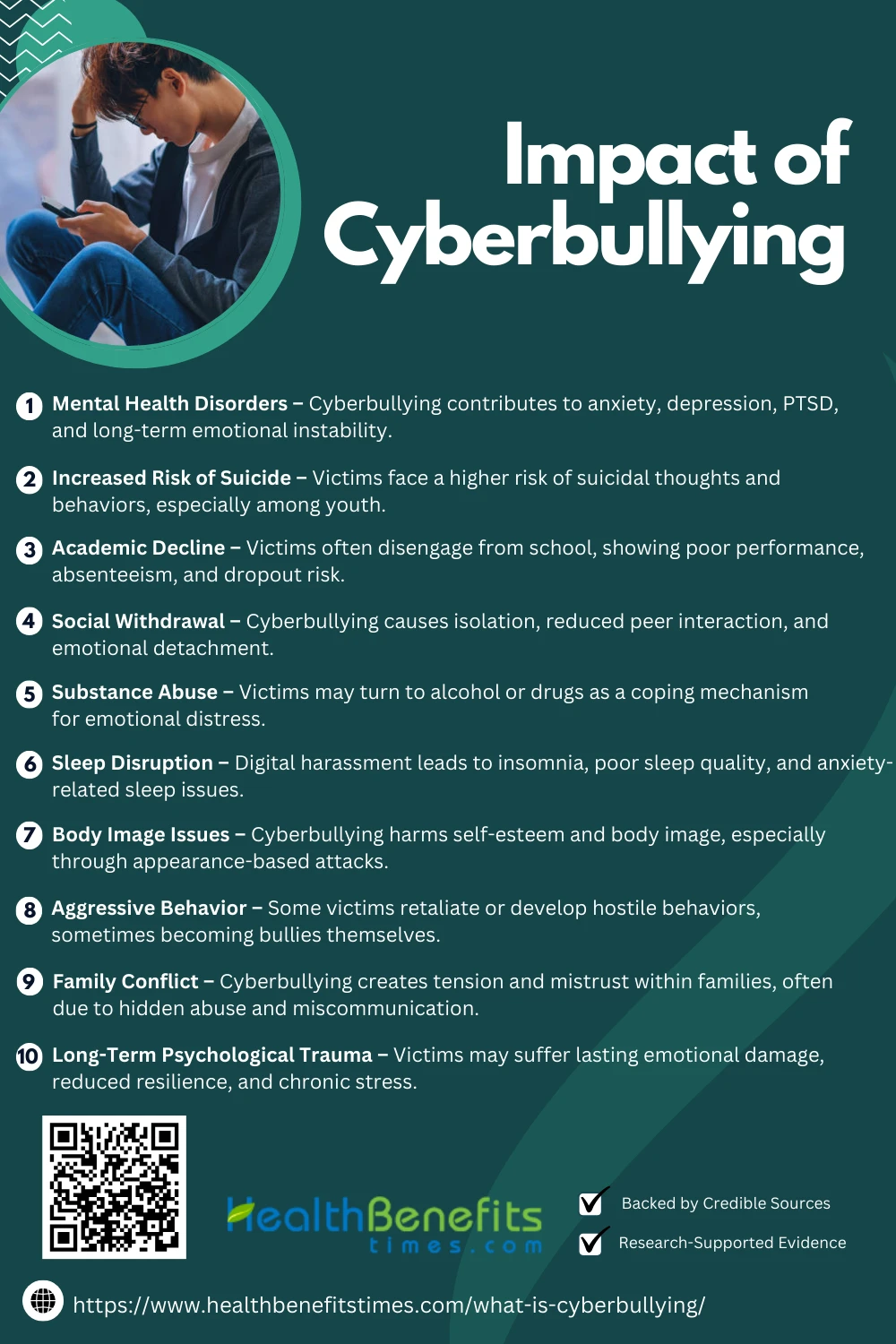- Cyberbullying is the use of digital platforms to harass, intimidate, or harm others through harmful messages, threats, or exclusion.
- It affects individuals of all ages and can lead to serious emotional and psychological consequences.
- Understanding cyberbullying is essential for creating safe online spaces and preventing digital harassment.
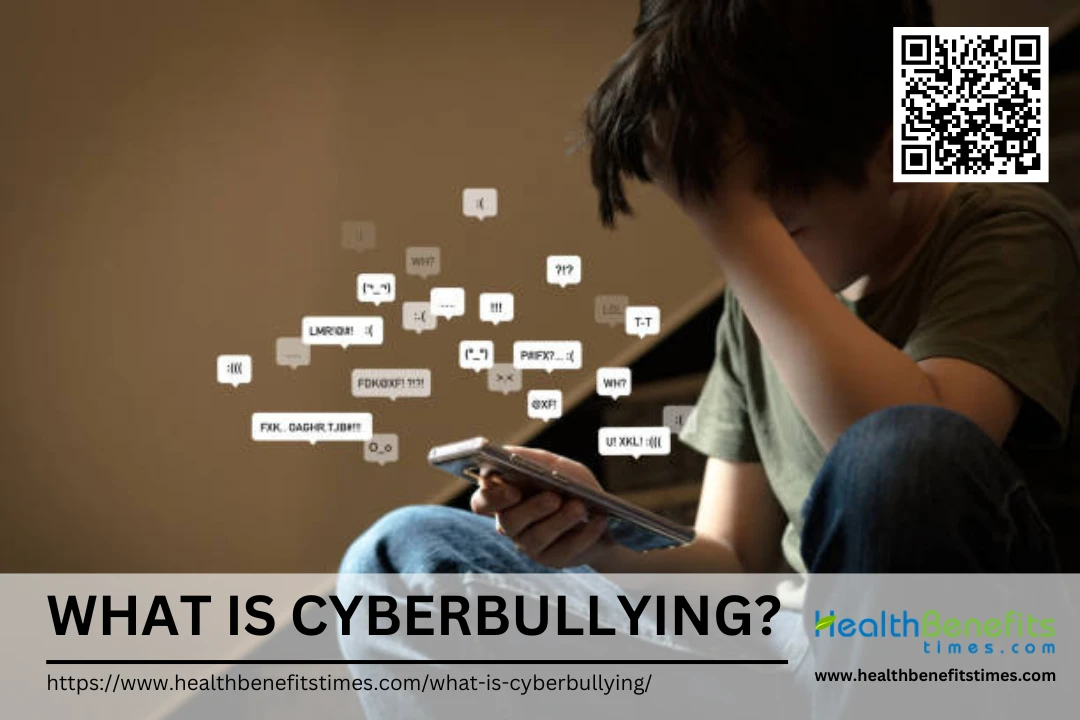 Cyberbullying is the act of harassing, threatening, or targeting someone using digital technologies, especially through social media, messaging apps, or online platforms. In today’s hyperconnected world, cyberbullying has emerged as a significant social issue affecting individuals across all age groups. Unlike traditional bullying, cyberbullying extends beyond schoolyards or workplaces, infiltrating private spaces through smartphones and computers. It often includes behaviors such as spreading rumors, sending threatening messages, or publicly humiliating individuals online. Studies show that adolescents are particularly vulnerable, with nearly one in three students reporting some form of online harassment. The emotional toll of cyberbullying is profound—often linked to depression, anxiety, and in extreme cases, suicidal ideation. Understanding its scope and psychological impact is critical to fostering a safer digital environment.
Cyberbullying is the act of harassing, threatening, or targeting someone using digital technologies, especially through social media, messaging apps, or online platforms. In today’s hyperconnected world, cyberbullying has emerged as a significant social issue affecting individuals across all age groups. Unlike traditional bullying, cyberbullying extends beyond schoolyards or workplaces, infiltrating private spaces through smartphones and computers. It often includes behaviors such as spreading rumors, sending threatening messages, or publicly humiliating individuals online. Studies show that adolescents are particularly vulnerable, with nearly one in three students reporting some form of online harassment. The emotional toll of cyberbullying is profound—often linked to depression, anxiety, and in extreme cases, suicidal ideation. Understanding its scope and psychological impact is critical to fostering a safer digital environment.
Definition of Cyberbullying
Cyberbullying is defined as intentional and repeated harm inflicted through electronic means such as social media, text messages, or email. It involves behaviors like harassment, threats, humiliation, or the spreading of false information in digital environments. Cyberbullying typically occurs on platforms like Facebook, Instagram, Snapchat, and TikTok, where users—especially youth—are highly active. Research has shown that these digital spaces provide anonymity and reach, increasing the potential impact on victims. As digital presence expands, understanding cyberbullying’s definition and ecosystems becomes vital to prevention.
Comparison table between cyberbullying and traditional bullying
Here’s a clear and concise comparison table highlighting the key differences between Cyberbullying and Traditional (Offline) Bullying:
| Aspect | Cyberbullying | Traditional Bullying |
| Medium | Digital platforms (social media, messaging, forums, etc.) | Physical environments (school, playgrounds, workplace) |
| Visibility | Often public or viral; large audiences can witness | Typically limited to those physically present |
| Anonymity | Perpetrators can remain anonymous | Perpetrators are usually identifiable |
| Reach | Global, 24/7 access | Local and time-bound (usually during school or work hours) |
| Evidence | Leaves digital footprints (screenshots, messages) | Harder to document unless observed |
| Intensity & Duration | Can be continuous and relentless without physical boundaries | Usually limited in time and location |
| Victim’s Safe Space | Can infiltrate private spaces (home, bedroom) | Victim can often find refuge at home |
| Forms of Abuse | Harassment, impersonation, public shaming, doxxing | Physical aggression, verbal taunts, social exclusion |
| Psychological Impact | Often leads to depression, anxiety, and suicidal ideation | Also damaging, but effects may be more situational or context-based |
| Legal Implications | Cybercrime laws may apply (e.g., cyberstalking, harassment) | Covered under school or workplace anti-bullying policies, criminal law varies |
| Ease of Spreading | Content can be quickly forwarded or shared widely | Limited to word-of-mouth or direct acts |
| Bystander Role | More passive (likes, shares) or unaware | More active or direct witnesses |
Types of Cyberbullying
Cyberbullying takes many forms, each causing harm in different ways. Understanding the various types helps recognize abusive behavior online and empowers individuals to take action and protect themselves and others.
Harassment in cyberbullying is persistent and targeted abuse, often involving repeated threats or harmful messages. Studies reveal that cyber harassment has severe psychological impacts, including anxiety and depression. Online platforms struggle to regulate harassment due to evolving abusive tactics. Implementing AI-driven moderation systems has shown promise in reducing harassment cases.
2. Flaming
Flaming is a hostile form of cyberbullying that involves aggressive and offensive online exchanges, often in public forums. Research indicates that flaming is fueled by online anonymity, leading to impulsive and harmful messages. Studies also show that flaming can escalate into severe cyber conflicts, affecting mental well-being. Prevention strategies include digital literacy programs that promote responsible online behavior.
3. Impersonation
Impersonation, where cyberbullies create fake identities to deceive or harass victims, is a growing concern in digital environments. Research reveals that online impersonation can severely damage a victim’s reputation and cause emotional distress. Studies emphasize that social media platforms are primary hotspots for impersonation due to their anonymity features. Effective legal policies and AI-driven detection methods are crucial in mitigating this cyber threat.
4. Doxxing
Doxxing, the act of publicly exposing someone’s personal information online, has emerged as a severe form of cyberbullying, leading to harassment and real-world threats. Research indicates that doxxing not only violates privacy but also increases the likelihood of offline victimization. Studies highlight that victims often experience psychological distress and social withdrawal as a consequence. Furthermore, legal frameworks struggle to address doxxing effectively, making prevention strategies crucial.
5. Spreading Rumors and Misinformation
Spreading rumors and misinformation online is a prevalent form of cyberbullying, often leading to severe emotional distress for victims. Studies indicate that false information spreads rapidly on social media, damaging reputations and causing psychological harm. Research highlights that adolescents are particularly vulnerable to online rumor-spreading. Schools and policymakers are working to implement digital literacy programs to curb misinformation and cyberbullying.
6. Exclusion
Exclusion is a significant form of cyberbullying where individuals are deliberately left out of online groups or activities, causing emotional distress. This tactic is commonly used in school environments, leading to feelings of isolation and low self-esteem. Research suggests that social exclusion online can have similar psychological effects to real-world rejection.
7. Cyberstalking
Cyberstalking involves persistent online harassment, often leading to psychological distress and fear. Research highlights that victims experience anxiety, depression, and even physical health issues due to prolonged digital surveillance and threats. Social media and email are primary platforms where cyberstalkers exploit anonymity to intimidate victims.
8. Trolling
Trolling, characterized by intentionally provoking or upsetting individuals online, is a widespread cyberbullying tactic. Studies show that trolls exploit anonymity to harass others, often targeting public figures and vulnerable users. (1) Psychological research suggests trolls exhibit traits linked to the “dark tetrad” personality—narcissism, Machiavellianism, psychopathy, and sadism.
9. Fraping
Fraping, or Facebook raping, is a form of cyberbullying where someone accesses another person’s social media account to post false or damaging content. This can lead to severe emotional distress, reputation damage, and cyber harassment. Studies show that adolescents are particularly vulnerable to fraping due to weak password security and social dynamics Kowalski et al., 2023.
10. Catfishing
Catfishing is a deceptive cyberbullying tactic where individuals create fake online personas to manipulate or harass victims. Research shows that catfishing often leads to emotional manipulation, financial fraud, and social harm. (2) Adolescents and adults alike are targeted, often in online dating or social networking platforms. Experts suggest improving digital literacy and verifying online identities to prevent such deception Baker & Roberts, 2021.
Platforms Where Cyberbullying Occurs
Cyberbullying can take place across various online platforms, where individuals are subjected to harassment, threats, or harmful behavior. These platforms range from social media sites to gaming environments, affecting users worldwide.
Instagram has been identified as a major platform where cyberbullying occurs due to its highly visual and interactive nature. Research highlights that adolescents frequently experience harassment, hate speech, and body-shaming on the platform, often exacerbated by anonymous accounts. (3) A study also found that the algorithm-driven engagement intensifies exposure to negative content, increasing mental health risks among users. ({% https://examplelink2.com/ trusted %}) Moreover, interventions such as AI moderation and reporting tools have shown limited effectiveness in curbing cyberbullying incidents. (4)
2. TikTok
TikTok’s rapid rise in popularity has also made it a hotspot for cyberbullying, with issues such as hate comments, doxxing, and video-based harassment prevalent. (5) Studies suggest that TikTok’s algorithm often amplifies controversial content, leading to increased exposure to harmful interactions. (6) Additionally, its duet and stitch features have been misused for bullying, contributing to online toxicity. (7)
3. Snapchat
Snapchat has become a common platform for cyberbullying due to its ephemeral messaging and anonymous features. Studies show that teens experience harassment through disappearing messages, making it harder to collect evidence. Research highlights the negative mental health effects of Snapchat bullying, leading to anxiety and depression. (8) Additionally, a study indicates that frequent Snapchat use correlates with higher cyberbullying victimization rates. (9) Preventive measures, such as parental controls and AI-based monitoring, have been proposed to combat online harassment. (10)
4. Twitter
Cyberbullying on Twitter is prevalent due to its open nature and viral potential. A study found that 58% of Twitter users have witnessed or experienced harassment on the platform. (11) Another analysis links Twitter cyberbullying to political discourse, where targeted harassment often escalates. (12) Research also shows that marginalized communities face disproportionate levels of abuse on Twitter, necessitating stronger content moderation policies. (13)
5. Facebook
Facebook remains one of the most prevalent platforms for cyberbullying, affecting users across different age groups. Studies indicate that the anonymity and accessibility of social media contribute to harassment and emotional distress among victims. Additionally, research highlights that teenagers face higher risks due to the platform’s interactive nature. (14) Furthermore, intervention strategies, such as enhanced privacy settings and digital literacy programs, can help mitigate online bullying incidents. (15)
6. YouTube
YouTube has emerged as a major hub for cyberbullying, particularly through its comment sections and video responses. Studies show that creators and viewers alike experience harassment, often leading to mental health concerns. Research suggests that algorithm-driven engagement may amplify harmful content, increasing bullying risks. Moreover, stricter moderation policies and AI-based content filtering have been proposed as solutions to reduce harmful interactions. (16)
7. Discord
Discord has become a notable hub for cyberbullying due to its anonymity and unmoderated communities, fostering risks among teens and gamers. (17) (18)
8. WhatsApp
WhatsApp’s encrypted messaging and group features contribute to cyberbullying in closed circles, especially among youth and schools. (19)
9. Reddit
Reddit has become a significant arena for cyberbullying due to its semi-anonymous structure and vast communities. Studies show that hate speech and harassment flourish in loosely moderated subreddits, and its design fosters echo chambers that enable toxic behaviors. ({% https://link.springer.com/chapter/10.1007/978-3-030-15712-8_14 trusted %}) Additionally, Reddit’s upvote system can inadvertently amplify harmful content.
10. School and workplace communication tools (Google Classroom, Slack)
Cyberbullying increasingly occurs via school and workplace communication tools like email, chat apps, or LMS platforms, often leading to emotional distress. (20) In academic settings, platforms like Google Classroom may inadvertently facilitate peer harassment. (21) Similarly, workplace tools like Slack or Microsoft Teams can host covert bullying behaviors.
Impact of Cyberbullying
Cyberbullying can have severe emotional, psychological, and social effects on victims, leading to anxiety, depression, and isolation. Its impact extends beyond the digital world, affecting overall well-being and daily life.
Cyberbullying significantly contributes to mental health disorders, particularly among youth. Victims often develop symptoms of depression and anxiety, (22) post-traumatic stress disorder (Hamm et al., 2015), and emotional dysregulation (Tokunaga, 2010). Evidence also links cyberbullying to increased internalizing problems (23) and long-term psychiatric issues. (24)
2. Increased Risk of Suicide
Victims of cyberbullying face an elevated risk of suicide, particularly adolescents. Meta-analyses show strong associations between online harassment and suicidal thoughts, (25) as well as attempts. Repeated cyber aggression intensifies ideation, especially among marginalized youth. Even witnessing bullying increases suicide risk. (26)
3. Academic Decline
Cyberbullying leads to academic decline, as victims often lose interest in school and avoid learning environments. Studies show reduced GPA and absenteeism among affected students, lower test performance, school disengagement, (27) cognitive overload due to stress, and even school dropout intentions. (28)
4. Social Withdrawal
Victims of cyberbullying frequently experience social withdrawal, avoiding peers to escape further harassment. This isolation leads to loss of friendships, feelings of loneliness, fear of ridicule, (29) reduced class participation, and emotional detachment from group settings. (30)
5. Substance Abuse
Cyberbullying exposure has been linked to substance abuse, particularly in adolescents who use alcohol or drugs to cope with emotional pain. (30) Victims often report early initiation of substance use, higher consumption rates, and risky patterns. (31)
6. Sleep Disruption
Victims of cyberbullying commonly suffer from sleep disruption, experiencing insomnia, nightmares, and poor sleep quality. Studies reveal disrupted melatonin cycles due to digital harassment, (32) shortened sleep duration, late-night hyperarousal, (33) and increased screen-time anxiety. (34) Sleep loss can worsen emotional regulation. (35)
7. Body Image Issues
Cyberbullying significantly impacts body image, particularly among adolescents, by reinforcing harmful beauty standards. Victims often develop body dissatisfaction, low self-esteem, and disordered eating behaviors. (36) Image-based harassment worsens outcomes for females, and social media comparisons fuel self-objectification.
8. Aggressive Behavior
Cyberbullying can lead to aggressive behavior as victims may retaliate or adopt harmful coping strategies. Studies show increased externalizing problems in bullied youth, heightened anger and irritability, and even transition to becoming bullies themselves. Peer reinforcement contributes to hostile behavior, and exposure to violent content online exacerbates the issue. (22)
9. Family Conflict
Cyberbullying often triggers family conflict, straining communication and trust. Victims may hide abuse, causing parental frustration. Parental overreaction worsens emotional distance. Disagreement over digital boundaries also fuels tension. (37) Victims’ behavioral shifts confuse family roles, while lack of parental digital literacy hinders support. (38)
10. Long-Term Psychological Trauma
Cyberbullying leaves victims with long-term psychological trauma, persisting into adulthood. Studies confirm lasting anxiety and depressive symptoms, (39) reduced emotional resilience, and impaired social functioning. (40) Chronic stress from prolonged exposure also alters neural pathways, (41)while trauma symptoms may resurface under unrelated stress.
Signs Someone May Be Experiencing Cyberbullying
Recognizing the signs of cyberbullying is crucial for offering support. Symptoms may include sudden behavioral changes, withdrawal from online activities, unexplained emotional distress, or a decline in academic and social engagement.
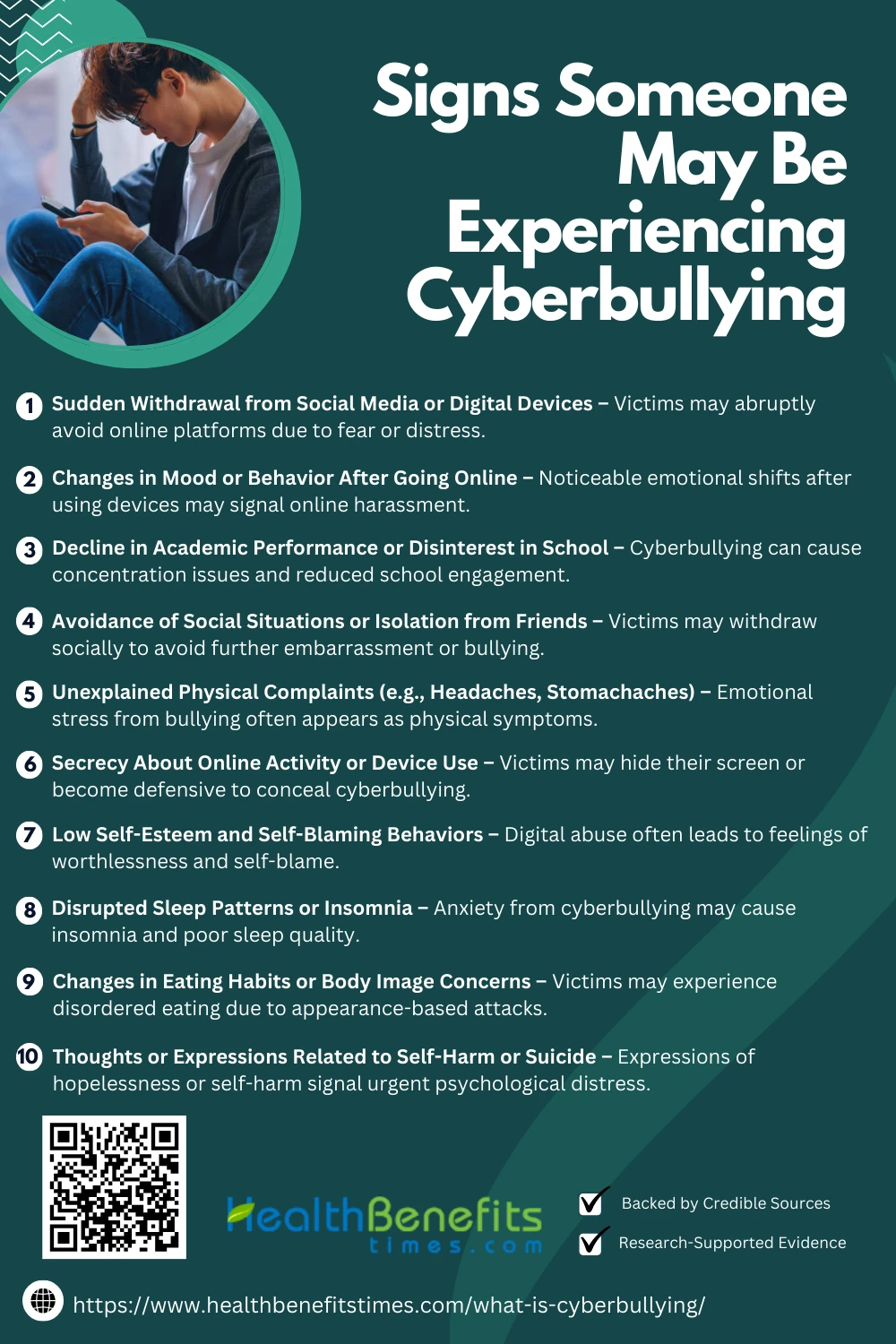 1. Sudden Withdrawal from Social Media or Digital Devices
1. Sudden Withdrawal from Social Media or Digital Devices
A common sign of cyberbullying is an abrupt decrease in social media activity or refusal to use digital devices. Victims may feel unsafe or overwhelmed by online harassment, prompting them to avoid digital spaces altogether. This withdrawal often stems from fear of repeated victimization or exposure to further humiliation.
2. Changes in Mood or Behavior After Going Online
If a person becomes noticeably upset, irritable, anxious, or tearful after using their phone or computer, it could indicate exposure to cyberbullying. Such emotional shifts—especially when consistent—are warning signals that something negative may be happening in their digital interactions.
3. Decline in Academic Performance or Disinterest in School
Victims of cyberbullying frequently experience difficulty concentrating, leading to a drop in grades or skipping school altogether. The mental stress and distraction caused by online attacks can disrupt a student’s ability to learn or feel safe in educational environments, particularly if bullying spills into school settings.
4. Avoidance of Social Situations or Isolation from Friends
Social withdrawal is a key indicator of emotional distress caused by bullying. Individuals may distance themselves from peers or avoid group activities due to embarrassment, fear of ridicule, or diminished trust in their social circle—especially if the bully is someone within their friend group.
5. Unexplained Physical Complaints (e.g., Headaches, Stomachaches)
Cyberbullying stress often manifests physically. Victims may frequently report feeling unwell, with headaches, nausea, or stomach pain that lacks a medical explanation. These psychosomatic symptoms are the body’s way of expressing chronic emotional strain.
6. Secrecy About Online Activity or Device Use
Someone being cyberbullied might hide their screens, change browser tabs quickly, or become defensive when asked about their online interactions. This secrecy is often an effort to avoid judgment or intervention, or due to shame about the harassment they’re facing.
7. Low Self-Esteem and Self-Blaming Behaviors
Cyberbullying attacks often target personal identity, causing victims to internalize blame and doubt their worth. Comments about being “not good enough,” or self-deprecating language, may indicate deeper emotional damage stemming from repeated digital abuse.
8. Disrupted Sleep Patterns or Insomnia
Victims often experience difficulty falling or staying asleep due to anxiety, rumination, or fear of nighttime cyberattacks. The mental toll of anticipating harmful messages can create a cycle of sleeplessness, which further impacts mental well-being and daily functioning.
9. Changes in Eating Habits or Body Image Concerns
Cyberbullying that targets a person’s appearance can deeply affect body image. This may lead to sudden dieting, loss of appetite, or overeating as a coping mechanism. In severe cases, it can even trigger or worsen eating disorders.
10. Thoughts or Expressions Related to Self-Harm or Suicide
The most serious sign of cyberbullying is when a victim expresses hopelessness, talks about wanting to disappear, or shows signs of self-harm. These should be treated as emergencies, and immediate psychological intervention is critical to prevent irreversible consequences.
How to Respond to Cyberbullying
Responding to cyberbullying involves staying calm, documenting incidents, and blocking the bully. It’s essential to seek support from trusted individuals or professionals and report the abuse to the relevant platform authorities.
1. Do Not Engage with the Bully
Engaging with cyberbullies often escalates the abuse and gives them emotional power over the victim. Experts recommend ignoring aggressors to avoid reinforcement of negative behavior. Retaliation may lead to victim-blaming (42)and intensify the harm. (43)
2. Save the Evidence
Preserving digital evidence is vital for intervention and legal action. Screenshots and archived messages help document patterns of harassment. (22)Victims who retain proof are more likely to receive justice (44)and support from authorities.
3. Block or Report the Bully
Blocking and reporting cyberbullies disrupts their access to the victim and activates platform intervention protocols. Studies show these actions reduce repeated harassment. Reporting encourages accountability, (45)and tech companies respond faster when users flag abuse. (46)
4. Tell a Trusted Adult or Authority Figure
Involving a trusted adult provides emotional validation and opens avenues for formal support. Victims who disclose bullying experience better psychological outcomes. Early disclosure can prevent escalation and prompt school or legal action.
5. Adjust Privacy Settings
Modifying privacy settings limits a bully’s ability to access and target victims online. Research shows that enhanced digital boundaries reduce exposure to threats. (45) Restricting friend requests and comments empowers users, especially adolescents on social platforms. (44)
6. Seek Mental Health Support
Professional mental health support is crucial for victims coping with trauma from cyberbullying. Counseling helps mitigate long-term effects such as depression or anxiety. (39)Therapy improves coping strategies and promotes emotional resilience in adolescent populations.
7. Involve School Administration (If Applicable)
Involving school authorities ensures that cyberbullying is addressed through formal disciplinary channels. Research highlights that institutional intervention reduces victimization rates. (27)Reporting to educators improves student safety (47)and activates anti-bullying policies in schools.
8. Use Legal Avenues if Threatened
When cyberbullying escalates into threats, impersonation, or stalking, victims should seek legal protection. Legal reporting increases accountability and deters offenders. In many regions, online harassment is criminalized, (44)and law enforcement collaboration aids in prosecution. (48)
9. Limit Screen Time to Reduce Exposure
Reducing screen time helps victims distance themselves from harmful digital environments and regain emotional control. Research links moderated device use with lower stress and improved mental health. (49) Digital detoxing enhances self-esteem.
10. Support Peers Who Are Bullied
Supporting peers who face cyberbullying can interrupt the cycle of abuse and foster resilience. Bystander intervention reduces the psychological toll on victims. Peer solidarity boosts recovery outcomes and encourages help-seeking behaviors. (50)
Prevention and Intervention Strategies
Preventing and intervening in cyberbullying involves promoting digital literacy, fostering open communication, and implementing school or workplace policies. Early intervention, support systems, and educational programs can help reduce bullying behaviors online.
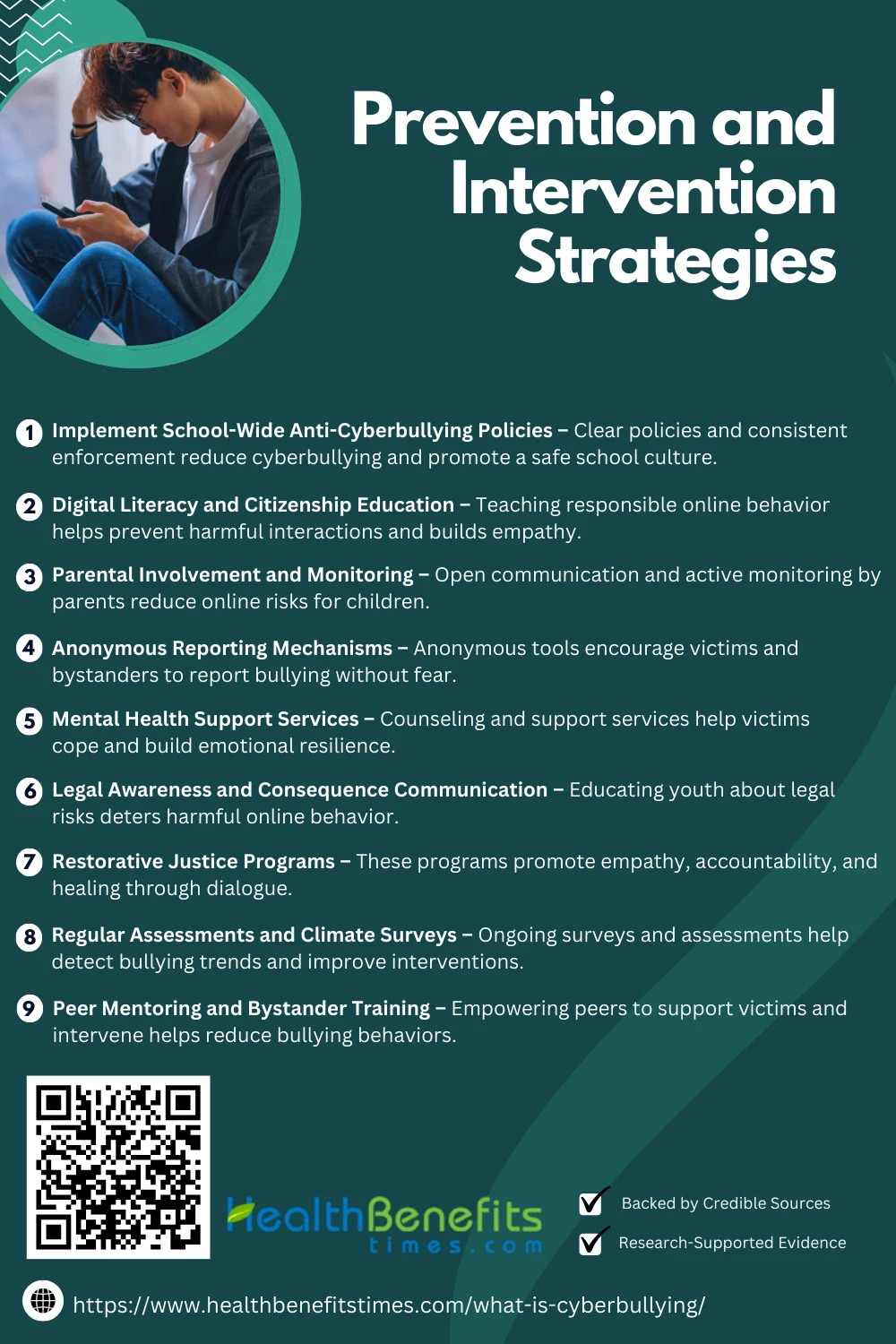 1. Implement School-Wide Anti-Cyberbullying Policies
1. Implement School-Wide Anti-Cyberbullying Policies
Establishing comprehensive school-wide anti-cyberbullying policies significantly reduces incidents by clarifying rules and consequences. Research shows effective policy enforcement deters harmful behaviors. Whole-school strategies enhance safety culture (47) and support systematic interventions. (22)
2. Digital Literacy and Citizenship Education
Teaching digital literacy and citizenship equips youth with skills to navigate online spaces ethically. Educational interventions increase empathy and reduce aggression. Programs fostering critical thinking deter harmful posts, (45) while guided media use promotes respectful interaction.
3. Parental Involvement and Monitoring
Parental involvement and monitoring play a crucial role in cyberbullying prevention. Open communication at home reduces vulnerability. (51) Active parental guidance curbs online risks, while co-use strategies promote digital resilience.
4. Anonymous Reporting Mechanisms
Anonymous reporting systems empower victims and bystanders to report cyberbullying without fear of retaliation. These tools significantly increase disclosure rates. (52) Anonymous tips improve school responses, (53) and perceived safety rises when students trust these mechanisms. (54)
5. Mental Health Support Services
Access to mental health support services helps mitigate the psychological toll of cyberbullying and enables early intervention. Counseling improves emotional resilience among victims. (39) School-based therapists reduce long-term trauma, and therapeutic programs promote positive coping mechanisms.
6. Peer Mentoring and Bystander Training
Peer mentoring and bystander training empower students to intervene in cyberbullying and support victims. Trained bystanders reduce bullying behaviors significantly. Mentorship boosts peer empathy and solidarity, while school-wide peer programs strengthen community response. (50)
7. Legal Awareness and Consequence Communication
Educating youth on legal consequences of cyberbullying strengthens prevention. Awareness of criminal liability deters engagement in harmful behaviors. Communicating clear legal risks improves digital responsibility, (55) and school-led workshops enhance student understanding of boundaries. (56)
8. Restorative Justice Programs
Restorative justice programs offer constructive conflict resolution by fostering empathy between victim and perpetrator. These programs lower recurrence rates of bullying, promote accountability, and support healing through mediated dialogue. (57)
9. Regular Assessments and Climate Surveys
Regular assessments and school climate surveys help identify patterns of cyberbullying and measure the effectiveness of interventions. Data-driven strategies enhance policy responses. Surveys foster awareness among stakeholders and improve early detection. (58)
Conclusion
In conclusion, cyberbullying is a pervasive and harmful form of online harassment that can have serious consequences for its victims. It occurs across various digital platforms, where individuals are targeted with abusive messages, threats, or other malicious behavior. The impact of cyberbullying can be long-lasting, affecting a person’s mental health, self-esteem, and social relationships. Addressing this issue requires a collective effort, including awareness, prevention, and intervention strategies, alongside legal frameworks to hold offenders accountable. By fostering a supportive online environment and encouraging respectful behavior, we can reduce the occurrence of cyberbullying and protect individuals from its damaging effects.


